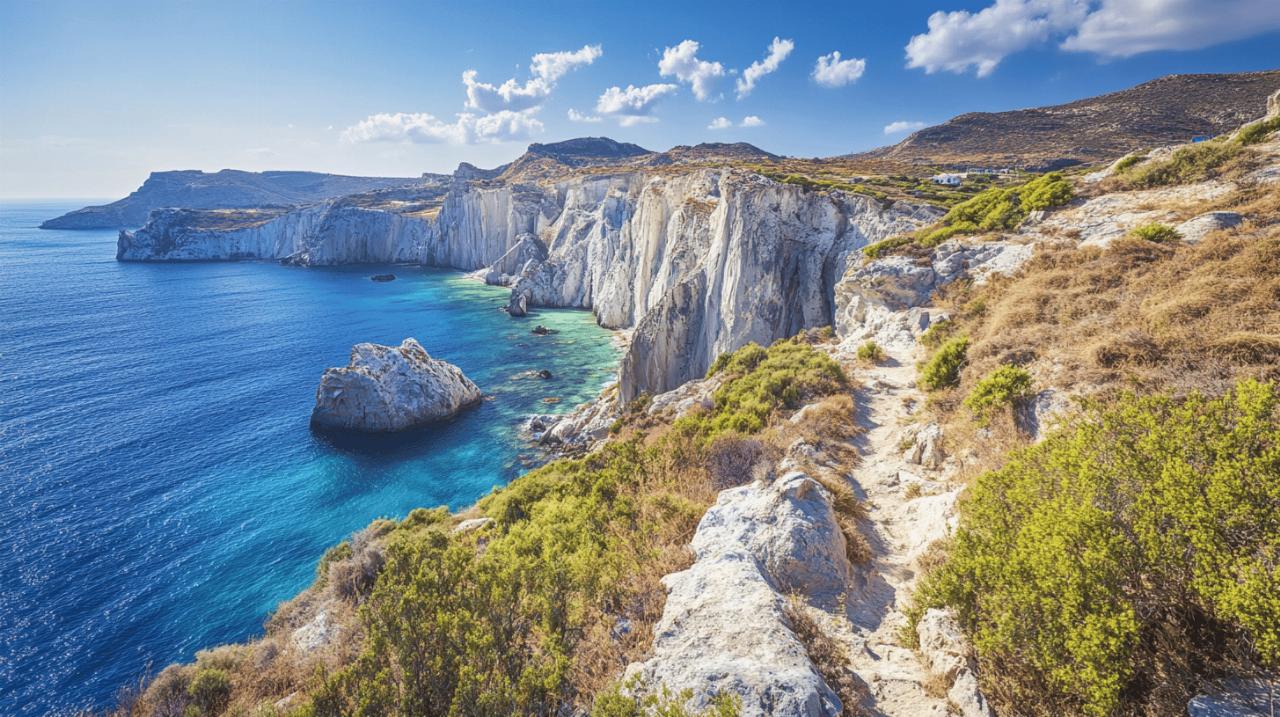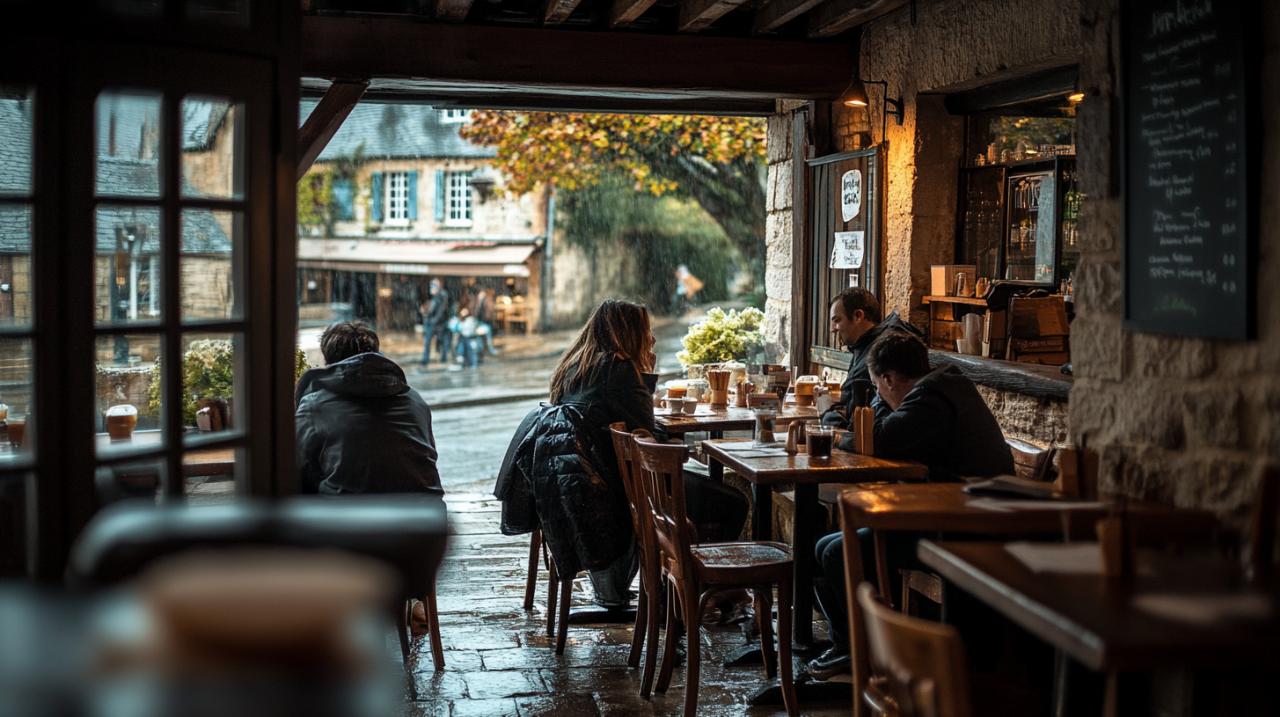Milos stands apart as one of the Cyclades' most rewarding destinations for those who seek adventure beyond the beach. This volcanic Greek island in the South Aegean offers a landscape that shifts from lunar-white rock formations to rugged coastlines, making it an extraordinary canvas for photography enthusiasts and walkers alike. Unlike its more famous neighbours Mykonos and Santorini, Milos retains a quieter charm, where the paths less travelled reveal hidden coves, ancient ruins, and sweeping vistas that beg to be captured through the lens. Whether you arrive by ferry from Piraeus or take a direct flight from Athens, the island welcomes you with the promise of discovery on foot, where every turn presents a new perspective and every ridge offers a panorama worthy of careful composition.
Prime Hiking Routes in Milos for Breathtaking Photography
Western coastal trails: dramatic cliffs and hidden coves
The western reaches of Milos harbour some of the most dramatic scenery in the Cyclades, where the volcanic geology has sculpted cliffs and sea caves into natural masterpieces. The trail leading towards Kleftiko Bay stands out as a photographer's dream, though reaching this iconic location requires commitment. The walking distances typically range from three to six kilometres across uneven, rocky terrain, so sturdy footwear becomes essential rather than optional. As you navigate the path, the landscape shifts from scrubland to coastal promontories, each vantage point revealing new angles of the towering rock formations that rise from the turquoise waters below. Mini Kleftiko offers a slightly more accessible alternative, though both destinations reward those willing to make the journey with compositions that capture the raw beauty of the island's volcanic heritage.
Further along the coast, the fishing village of Mandrakia provides a gentler walking experience whilst still offering compelling photographic opportunities. The traditional boathouses, painted in faded pastels, cluster along the waterfront, their weathered textures contrasting beautifully with the crystalline sea. From Mandrakia, you can extend your ramble to neighbouring coves, where the interplay of light on water and rock creates ever-changing conditions throughout the day. The white volcanic landscape of Sarakiniko Beach lies within reasonable walking distance from Adamas, the island's main port, making it an ideal destination for those seeking moon-like terrain without venturing too far from their base. The smooth, wind-sculpted formations here resemble an otherworldly sculpture garden, particularly striking when caught in the golden hour light that transforms the white stone into warm amber tones.
Inland paths: volcanic landscapes and panoramic island vistas
Moving away from the coastline, the interior trails of Milos reveal a different character altogether. The paths leading towards Plaka, the island's hilltop capital, offer panoramic views that encompass much of the island's territory, with the sea glittering on multiple horizons. The walk up to Plaka Castle at sunset has become something of a pilgrimage for visitors, and rightfully so. The ruins of this Venetian fortress provide a natural vantage point where you can watch the sun sink into the Aegean whilst the villages below begin to twinkle with evening lights. The elevation gain on this route proves moderate but steady, and the reward extends beyond the sunset itself to include a sweeping perspective of the Cycladic archipelago stretching towards Serifos, Sifnos, and beyond.
The mining heritage of Milos adds another dimension to inland exploration, with abandoned quarries and processing sites creating unexpected photographic subjects. These industrial remnants, gradually being reclaimed by nature, offer a poignant contrast to the island's pristine beaches and quaint fishing villages. When planning these inland walks, remember that the Greek sun shows little mercy, particularly during the high season months of July and August. Bringing at least one and a half litres of water per person becomes crucial, along with sun protection and a hat. The terrain underfoot varies considerably, from well-trodden paths near villages to rougher tracks across volcanic rock, so assessing your fitness level honestly before setting out proves wise. Weather-resistant camera equipment also merits consideration, as conditions can shift quickly, and protecting your gear whilst navigating uneven ground requires attention.
Essential tips for planning your milos walking photography expedition
Gear and Safety: What to Pack for Hiking in the Greek Sun
Preparing properly for a walking tour on Milos makes the difference between an enjoyable adventure and an exhausting ordeal. The foundation of any successful outing lies in appropriate footwear, as the rocky, uneven terrain demands shoes with good ankle support and robust soles. Lightweight hiking boots or sturdy trail shoes prove ideal, whilst fashion trainers or sandals simply won't suffice for anything beyond a beach stroll. Beyond your feet, sun protection becomes paramount. A wide-brimmed hat, high-factor sun cream, and sunglasses with good UV protection should feature in every day pack, regardless of the season. Spring and autumn months may feel milder, but the Mediterranean sun maintains its intensity even when temperatures moderate.
For photography enthusiasts, the question of what camera gear to carry requires careful consideration. A weather-resistant camera body and lenses provide peace of mind when coastal breezes kick up spray or dust, whilst a sturdy camera strap prevents accidents on uneven ground. Many photographers find that a lightweight tripod enhances their options, particularly for capturing long exposures of the sea or perfectly composed sunset shots from Plaka Castle. However, every additional piece of equipment adds weight, and balancing photographic ambitions with physical comfort becomes part of the planning process. A polarising filter proves invaluable for managing the intense light reflected off white volcanic rock and blue water, cutting through glare to reveal the true colours beneath. Pack spare batteries and memory cards, as opportunities to recharge or purchase supplies may prove limited once you leave Adamas or other main settlements.
Travel logistics: flights, ferries, and accommodation arrangements
Getting to Milos requires some advance planning, particularly during the peak summer months when demand for both flights and ferry crossings increases substantially. Direct flights from Athens to Milos take approximately forty minutes, making this the quickest option for those with limited time. However, booking these flights well in advance proves essential, as availability becomes tight during high season. The alternative route involves taking a ferry from Piraeus port in Athens, a journey of five to six hours that costs around seventy-five euros for a one-way ticket. Reaching Piraeus from central Athens typically requires either navigating public transport or taking a taxi, with the latter option costing approximately sixty euros. Factor this into your overall budget and timeline, as missing a ferry departure can disrupt carefully laid plans.
Once on the island, accommodation options range from family-run studios to boutique properties such as Volcano Luxury Suites, which offers just seven rooms and tends to book up quickly. Adamas serves as an excellent base for walkers, with its central location providing easy access to many trailheads, along with amenities including gear rentals and local guides who can tailor routes to your interests and abilities. Plaka offers a more atmospheric setting, perched on its hillside with sunset views built into the accommodation price, whilst Pollonia attracts those seeking a quieter alternative with a selection of hotels near a fishing village atmosphere. When booking, ensure your passport or identification card remains valid for the duration of your stay, and check any forms or authorisation required for your specific circumstances. Renting a car becomes highly advisable for serious walkers and photographers, as public buses, whilst adequate for reaching major beaches, don't serve the more remote trailheads. Book an automatic transmission vehicle early, as these prove popular and limited in number.
Capturing Milos: Best Times and Locations for Photography
Golden hour magic: sunset and sunrise viewpoints
 The quality of light defines great landscape photography, and Milos delivers exceptional conditions throughout the day. However, the golden hours around sunrise and sunset transform the island into something truly magical. The westward-facing coastline means that sunset locations dominate the popular itinerary, with Plaka Castle claiming top honours for its commanding position and romantic atmosphere. Arriving early secures a good spot, as this viewpoint attracts crowds during peak season. The castle ruins frame the descending sun beautifully, whilst the villages of Plaka, Klima, and Pollonia spread below, their white buildings glowing in the warm light. For a less crowded sunset experience, consider heading to the cliffs above Kleftiko or finding a quiet spot along the western coastal path, where you can compose your shots without jostling for position.
The quality of light defines great landscape photography, and Milos delivers exceptional conditions throughout the day. However, the golden hours around sunrise and sunset transform the island into something truly magical. The westward-facing coastline means that sunset locations dominate the popular itinerary, with Plaka Castle claiming top honours for its commanding position and romantic atmosphere. Arriving early secures a good spot, as this viewpoint attracts crowds during peak season. The castle ruins frame the descending sun beautifully, whilst the villages of Plaka, Klima, and Pollonia spread below, their white buildings glowing in the warm light. For a less crowded sunset experience, consider heading to the cliffs above Kleftiko or finding a quiet spot along the western coastal path, where you can compose your shots without jostling for position.
Sunrise photography on Milos offers equally compelling opportunities with the bonus of solitude, as few visitors rouse themselves early enough to witness dawn breaking over the Aegean. The eastern beaches, including Palochori Beach with its mix of sand and rocks, provide excellent foreground interest for sunrise compositions. The changing light conditions in spring and autumn prove particularly favourable for photography, with softer, warmer tones that enhance the natural colours of the landscape. May through June and September through October represent the sweet spot for photographers, combining ideal lighting with more comfortable temperatures for walking and fewer crowds competing for the best vantage points. During these months, you can spend more time perfecting your compositions without the pressure of peak summer heat or the need to share space with multiple tour groups.
Cultural Landmarks Along the Trail: Ancient Theatres and Catacombs
Milos offers more than natural beauty, with cultural and historical sites adding depth to your walking itinerary. The Catacombs, located near the village of Klima, represent one of the earliest Christian burial sites in Greece, dating back to the first century. An entry fee applies, but the small investment grants access not only to the archaeological site itself but also to a viewpoint overlooking the coast. The walk to the Catacombs from Adamas proves manageable for most fitness levels, following a coastal path that offers regular photo opportunities of the sea and the colourful fishing village below. The ancient theatre, though less famous than its counterparts on other Greek islands, provides another glimpse into Milos's long history, with its restored seating carved into the hillside offering views across the bay.
These cultural landmarks integrate naturally into longer walking routes, allowing you to combine physical activity with historical exploration. After visiting the Catacombs, many walkers continue to Klima itself, where the traditional syrmata, or boathouses built directly into the rock, present irresistible photographic subjects. The bright doors and shutters, each painted a different colour, create a playful contrast with the volcanic stone and blue sea. Mandrakia offers a similar scene with arguably more authentic charm and fewer visitors. Plan to arrive around midday when the fishing boats return and local tavernas serve fresh seafood, providing both a cultural experience and a well-earned rest before continuing your exploration. Remember that visiting these villages and archaeological sites requires respect for both the residents and the historical significance of the locations, so seek any necessary authorisation before entering private property or restricted areas.
Responsible hiking and island hopping opportunities
Sustainable tourism: preserving milos's natural beauty
As Milos grows in popularity, the responsibility falls on visitors to minimise their impact on this fragile island environment. Staying on marked paths protects both the landscape and yourself, as venturing off established routes can damage delicate vegetation and increase erosion on already unstable slopes. The island supports important wildlife populations, including colonies of Eleonora's falcons and various seabirds that nest in the coastal cliffs. Observing these creatures from a respectful distance ensures they can continue their breeding cycles undisturbed. Mediterranean monk seals occasionally visit the more remote coves around Milos, and though sightings prove rare, their presence underscores the ecological importance of maintaining clean, quiet coastal areas.
Leave no trace principles apply as much on Greek islands as in any wilderness area. Carry out everything you carry in, including food wrappers and water bottles, as litter not only mars the landscape but also poses risks to wildlife. When exploring beaches and coves, resist the temptation to collect shells, rocks, or other natural souvenirs, as removing these items gradually degrades the environment. If you encounter snakes whilst hiking, particularly around Kleftiko or other rocky areas, give them wide berth and allow them to retreat. Most species native to Milos pose little threat to humans unless provoked. By practicing responsible tourism, you contribute to preserving Milos for future generations of walkers and photographers, ensuring that the island's natural beauty endures despite increasing visitor numbers.
Extending your adventure: nearby islands worth exploring
Milos serves as an excellent starting point for exploring the wider Cyclades, with several neighbouring islands easily accessible by ferry. Kimolos lies just a short crossing away, visible from western Milos and offering its own network of walking trails through a landscape of white rock and traditional villages. Sifnos, another nearby island, has built a reputation among walking enthusiasts for its network of maintained paths connecting mountain villages and coastal settlements. The island's interior proves particularly rewarding, with ancient trails winding through olive groves and past Byzantine churches. Serifos presents a more rugged character, its dramatic terrain appealing to those seeking challenging walks with significant elevation changes and remote beaches as rewards for the effort expended.
Island hopping adds another dimension to your Greek adventure, allowing you to experience the unique character of each destination whilst building a comprehensive understanding of Cycladic culture and geography. Naxos, the largest of the Cyclades, offers extensive hiking opportunities ranging from coastal paths to mountain trails leading to traditional marble villages. Amorgos, further east, appeals to those seeking a quieter experience with dramatic cliff-top monasteries and a slower pace of life. When planning a multi-island itinerary, book ferry transfers in advance, particularly during high season when popular routes fill quickly. Check luggage weight requirements, as restrictions vary between ferry operators, and ensure you have sufficient time between connections to account for potential delays. Whether you choose to focus intensively on Milos or use it as a base for wider exploration, the Cyclades reward those who take the time to explore on foot, revealing layers of beauty and history that remain invisible to those who never venture beyond the beach.







